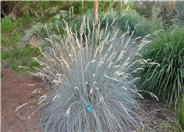
Common name:Blue Oat Grass
Botanical name:Helictotrichon sempervirens
Blue oat grass is a striking ornamental grass with blue foliage and a clumping habit. It grows 12 to 18 inches tall and wide. Its showy flowers are 1 to 2 feet above the foliage. Is evergreen in mild winters. This plant looks good alone as well as in mass plantings. The blue oat grass likes dry hill sides and is drought tolerant.
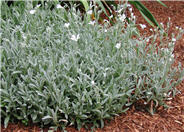
Common name:Snow-In-Summer
Botanical name:Cerastium tomentosum
Masses of snow white flowers cover this plant from late spring to early summer. Fine textured foliage is silvery grey. After flowering, shear back plant to encourage new foliage and for a tidy appearance. Over-head watering may cause the plant to "melt-out" in the center; over-watering, in general, causes the plant to die out over time. An attractive filler among other plants and rocks, and nice ground cover for areas that receive little foot traffic. Plant at edges of walks to soften paths. I saw a lovely planting where cerastium was used to represent water in a "dry creek" design-Brilliant. Grows 4 to 5 inches tall and 15 to 18 inches wide.
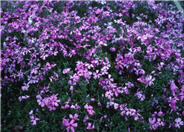
Common name:Moss Phlox
Botanical name:Phlox subulata
Moss phlox (also moss pink, mountain phlox, or creeping phlox) is a vigorous, spreading, mat-forming, sun-loving phlox that grows to only 6 inches tall but spreads to 24 inches wide. It is noted for it creeping habit, its linear leaves, and its profuse carpet of mid-spring (April to May) flowers with notched flower petals. Many cultivars of this plant are available in commerce featuring flower colors of blue, purple, pink, red and white.
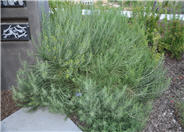
Common name:Rubber Rabbitbrush
Botanical name:Chrysothamnus nauseosus
Rubber rabittbrush is a Utah native, known for its chrome-yellow autumn flowers and strikingly white stems. This plant will reach a mature size of about 4 to 6 feet tall and wide. Fall flowers are chrome-yellow and cover the entire plant. Foliage is long, narrow, grey-green, and slightly hairy, giving it a whitish cast. It is semi-deciduous, and will hold its foliage well into the autumn and early winter. A great shrub for a hot, dry site.
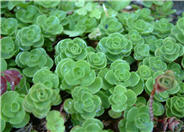
Common name:Pacific, Round, or Yellow Stonecrop
Botanical name:Sedum spathulifolium
This species of sedum is quite low, usually under 4 inches. Leaves are somewhat rounded, thick and fleshy with a unusual white powdery coating which lends a white to grey-green appearance. In early summer, they produce flat-topped clusters of yellow flowers. In autumn, leaves often turn reddish to purplish. In fact, this plants foliage seems to change color constantly all year round. They are particularly well suited for mixing among Sempervivums and other low stonecrops in the rockery, front of the perennial border or alpine troughs.
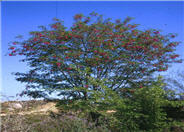
Common name:Purple Robe Locust
Botanical name:Robinia pseudoacacia 'Purple Robe'
Purple Robe Locust is a medium-sized upright tree, growing 40 feet in height with a compact, rounded form. The trunk is long and straight with an interesting branching pattern. Leaves are dull, dark blue-green and pinnately compounded. Fall color is yellow. Flowers are dark rose-pink, in dense clusters, May to June. Lonf, slender pods follow flowers and persist into autumn. Bark is warm gray and furrowed; branches have spines.
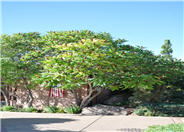
Common name:Staghorn Sumac
Botanical name:Rhus typhina
Staghorn sumac is an open, spreading shrub or small tree that typically grows 15 to 25 feet tall, and though individual plants are narrow, colonies can spread 20 to 30 feet wide. It is particularly noted for the reddish-brown hairs that cover the young branchlets in somewhat the same way that velvet covers the horns of a stag, hence the common name. It is also noted for its ornamental fruiting clusters and excellent fall foliage color. Large, compound, odd-pinnate leaves (each to 24 inches long) are bright green above during the growing season and glaucous beneath. Leaves turn attractive shades of yellow/orange/red in autumn. Each leaf has 13-27 toothed, lanceolate-oblong leaflets (each to 2 to 5 inches long). Tiny, greenish-yellow flowers bloom in terminal cone-shaped panicles in summer (June-July), with male and female flower cones primarily occurring on separate plants (dioecious). Female flowers produce showy pyramidal fruiting clusters (to 8 inches long), with each cluster containing numerous hairy, berry-like drupes which ripen bright red in autumn, gradually turning dark red as they persist through much of the winter. Fruit is attractive to wildlife. Wood is a warm grey to soft brown and is smooth. Use in naturally-styled landscapes, and where it has room to spread.
| Designer: Rick Laughlin | Dymondia Pond 7 |
Photographer: GardenSoft |
Water Saving Tip:
Group plants in your garden according to their water needs (hydrozone).
